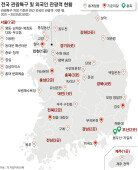[Editorial] Government Should Recognize Failure of Its Real Estate Policy
[Editorial] Government Should Recognize Failure of Its Real Estate Policy
Posted June. 04, 2005 06:29,
The incumbent government has come up with more than 30 measures to stabilize housing prices since its inauguration. The core idea was to levy heavy real estate taxes mainly on some regions such as the Gangnam area in Seoul. At the same time, it has presented various development projects including not only administrative city but also corporate cities and revolutionary cities, while raising the issue of balanced regional development.
Then, what is the outcome? Housing and land prices in Gangnam area have been surging greatly. President Roh has repeatedly emphasized a war against real estate speculation, but the trend of increasing housing prices has been spreading to the northern part of Gyeonggi-Do such as Gwacheon, Bundang, Yong-in, and Pyeongchon.
Whereas the price for 50-plus pyeong apartments in Gangnam area in Seoul has dramatically increased by more than 300 million won during one month, those for the apartments in the Gangbuk area have been falling. The overall prices of apartments in Seoul increased 0.61 percent on average from May 6 to May 27. The growth rate of apartment prices in the Gangnam, Seocho, and Songpa areas, mainly targeted by the government, is nearly double the average for the whole area of Seoul.
The land prices of the whole country, in terms of declared land prices, exceeded 2,000 trillion won, with 500 trillion won of that coming as increases over the last two years. Separately declared land prices surged 18.9 percent on average compared to the previous year, which is the highest figure since 1990 when disclosed land prices were first followed up on.
In 2003, when the incumbent government was inaugurated, it was an unavoidable fact that real estate prices would increase. During the Kim Dae-jung administration poured hundreds of trillions of won into the market starting in 2000 in order to excessively expand consumption. On the other hand, the incumbent government did not let the money go to more productive sectors via corporation-friendly and market-friendly policies, but instead stuck to its policies of contracting corporate investment while emphasizing only distribution and balance. The result was that all the money has gone to real estate speculation and overseas, while distribution issues were not resolved at all.
It is not too much to say that the incumbent governments policies on the housing market have been consistently radical. It has focused on strengthening regulations rather than on increasing the supply in the middle and long term. The government has introduced betterment recapture and infrastructure allotment measures in order to crack down on reconstruction-related speculation in Gangnam area, which now generates a vicious circle of supply contractions and price increases. The housing prices of the Gangnam area in Seoul should increase further on the prospects that supply will be much tighter in the foreseeable future.
On the other hand, the housing prices of low-demand areas such as Gangbuk, Seoul are falling as the policies backfire. The government should take responsibility for the unbalanced polarization. The heavy burden of real estate taxes has been a stumbling block to economic recovery while worsening depressed consumption.
In order to stabilize housing prices, increasing the supply of houses in areas where prices are rapidly rising should come first, which is a simple idea based on market principles and common sense. At the same time, with a far-sighted perspective, it is necessary to reduce the demand for houses in the Gangnam area while improving education and the infrastructure of other areas. The current policy based on suppressing supplies cannot be successful.
Land prices are also a problem. Although the government has advocated balanced regional development, the result is that only the development issue has survived--the balance issue has disappeared--and that the whole country is subject to speculation. The government plans to construct 11 revolutionary cities and four corporate cities in addition to the administrative city. It is said that most of the capital will be funded from selling land to people, but the prospects of land becoming so expensive that purchasing and selling of land will go as smoothly as originally planned are unclear.
The increase in land prices is directly related to corporate competitiveness. Compared to China, Korea has nine-fold higher wages, 3.6-fold higher land, and a 1.8-fold higher corporate tax rate. The land price per square meters is 147,000 won for Korea and 40,740 won for China. The state of Alabama in the U.S. provided 210,000 pyeong of land for a plant site for nothing. When corporations have found it difficult to conduct business due to high wages, taxes, and various stringent regulations, raising land prices is not different from expelling corporations overseas.
The increased land price will lead to a rise in housing prices, which will make it more difficult for ordinary people to buy houses. And it will increase the expenses of land compensation for government-sponsored projects, thus multiplying the peoples tax burden. It can be said that the land price increase will end up as a situation where speculative spirit and unsound labor culture prevail. The profits from land price increases do not go to people in the regions involved. Most sites awaiting development are owned by outside people aiming at speculation.
The government should confront the housing and land price problems that radical real estate and unbalanced regional development policies have caused. These policy failures have been at the root of the turmoil. The government should candidly acknowledge its policy failures and search for policy alternatives that respect market principles.
Headline News
- N. Korea redefines S. Korea as ‘hostile state’ in revised constitution
- Samsung develops graphic DRAM with industry-leading capacity and speed
- Three questions allegedly leaked via text message during Yonsei Univ. essay test
- China to inject 340 trillion won in loans to support real estate sector
- Dodgers beat Mets to take 2-1 lead in NLCS







